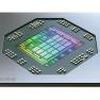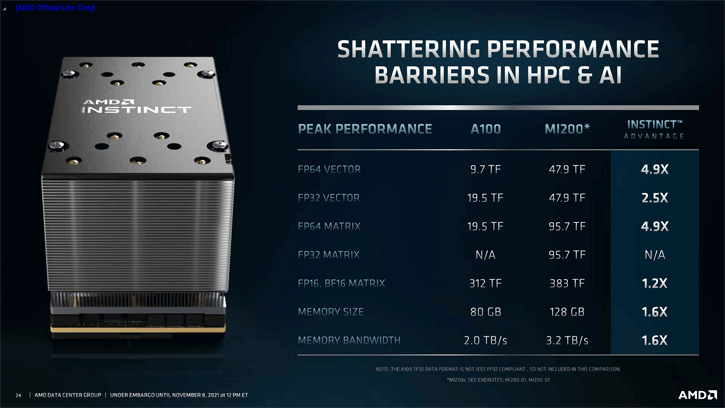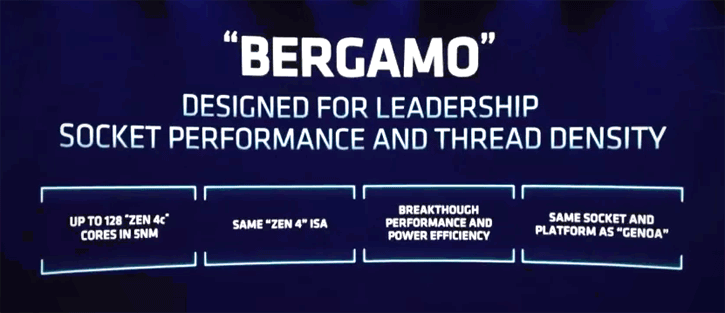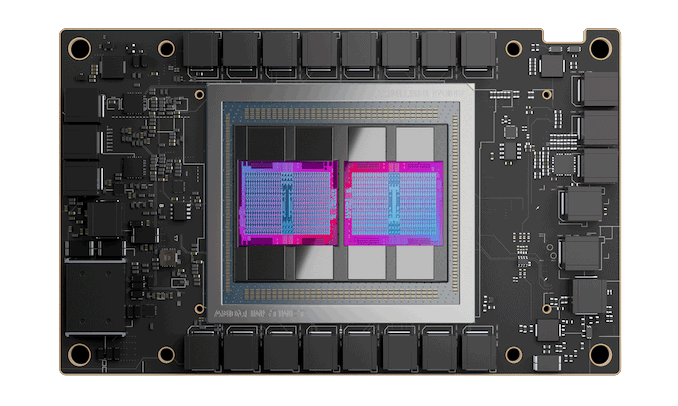3rd Gen AMD EPYC processors with AMD 3D V-Cache were announced at the virtual Accelerated Data Center Premiere. AMD also mentioned the new “Zen 4c” CPU, which will power future AMD server processors and extend the company's leadership offerings for the data center as well as MI200 with an MCM design
EPYC Generation 3 processors (Milan-X)
This one wasn't exactly a surprise, AMD will be applying 3D chiplet technology, whereas 3d of course refers towards stacking. Codenamed Milan-X shows 3D chiplet technology combined with 3D V-Cache for Epyc processors in the near future. AMD 3D V-Cache could quite possibly target specific data center workloads. The enhanced socket SP3 processors will require a BIOS update for Milan-X, but do not require software patching. With up to 64 Zen 3 cores now come with three times the L3 cache of their predecessors, for a total of up to 804MB total (L2 and L3) cache per socket (768MB of total L3 cache per chip), up from the previous two.
| Processor | Cores/Threads | Base Clock | Boost Clock | TDP | L3 Cache (L3 + 3D V-Cache) |
| Epyc 7773X | 64/128 | 2.2 GHz | 3.5 GHz | 280 W | 768 MB |
| Epyc 7573X | 32/64 | 2.8 GHz | 3.6 GHz | 280 W | 768 MB |
| Epyc 7473X | 24/48 | 2.8 GHz | 3.7 GHz | 240 W | 768 MB |
| Epyc 7373X | 16/32 | 3.05 GHz | 3.8 GHz | 240 W | 768 MB |
According to AMD, the consequence of this technology offers a "50 percent average uplift across specified operations." AMD showcased Milan-X at today's presentation, demonstrating that it can do chip design verification work 66 percent more quickly than Milan. Although this is the best-case situation for the cache-tripling technology, it demonstrates how AMD is targeting specific workflows with a diverse range of chip designs. Mind you that AMD plans to release Ryzen processors with 3D V-Cache in the first quarter of 2022 as well.
Instinct MI200
AMD's new Instinct accelerator will be the first MCM-based GPU featuring 2 x Compute Tiles with 110 Compute Units and 128GB of HBM2e memory that should be able to generate a significant amount of memory bandwidth per second. The GPU has 2x Compute Tiles offering something close to 383 TFLOPs, easily outperforming the Instinct MI100, which has a total compute performance of 185 TFLOPs. The Instinct MI200 series is boasting features like so: two AMD CDNA2 dies, up to 58 billion transistors fabbed at a 6nm node. This also entails up to 220 compute units, up to 128GB of HBM2e at 3.2TB/s, and up to 880 2nd gen matrix cores, among other things.
AMD has coupled the two CDNA2 dies using ultra high bandwidth 3rd generation Infinity Fabric interconnects with coherent CPU-to-GPU interconnects, as well as a 2.5D elevated fanout bridge, to ensure that all of the above functions in seamless harmony (EFB). Compared to the previous-generation GPUs, "EFB technology delivers 1.8x more cores and 2.7x higher memory bandwidth," according to AMD.
AMD claims that its new Instinct MI200 series is "shattering performance barriers in high-performance computing and artificial intelligence," and in its own tests, the peak performance of the MI200 placed it significantly ahead of the Nvidia A100 in both high-performance computing and artificial intelligence applications and benchmarks.
AMD is introducing its Instinct MI200 series in the OCP Accelerator Module (OAM) form format, a new form factor for the company.
ZEN 4 going for a 128-core behemoth; Bergamo ...
AMD saved some of the best news for last, announcing and teasing that its next-generation Zen 4-based Genoa Epyc processor will be expanded by new processors known under codename Bergamo in 2023. It is anticipated that they will be used in cloud computing infrastructure and wait for it ... it can have up to 128 cores, an increase from the previous maximum of 96 cores on Genoa (2022). They will be built on a 5nm Zen 4c platform, with the small-case c referring to their anticipated use in cloud computing infrastructure. We learned that Genoa supports DDR5 and PCIe 5.0. E.h. ZEN4 will be DDR5 and PCIe 5.0 compatible. So yeah AMD has a thing or two for is in the pipeline, and 128-core processors, blimey.
In short;
- The flagship 4th Gen AMD EPYC processor, codenamed “Genoa,” is expected to be the world’s highest performance processor for general-purpose computing. It will have up to 96 high-performance “Zen 4” cores and will support the next generation of memory and I/O technologies.
- “Genoa” is on track for production and launch in 2022.
- AMD also announced the “Zen 4c” core, tailor-made for cloud native applications. These cores are software compatible with “Zen 4” and optimized to enable higher-core count configurations for cloud native workloads that benefit from maximum thread density.
- The upcoming “Bergamo” processor features 128 high performance “Zen 4c” cores and comes with all the same software and security features and is socket compatible with “Genoa.” “Bergamo” is on track to ship in the first half of 2023.
The EPYC Genoa chips will have up to 96 Zen 4 cores and support DDR5 and PCIe 5.0





